If you are curious, this is what you will learn about the CDT vaccine for goats: should you give it or not? Learn what it means, what it’s for, symptoms, treatments, prevention, and where to give the shot, and other alternatives to giving the shot. Your goats rely on you to keep them safe and healthy and this is one area that is absolutely necessary to know about.
Watch the Video about CDT by clicking the video below.
If you like this information, my YouTube channel is full of even more goat information. Please click this link: Delci | A Life of Heritage and subscribe! You can also click this link to watch this information on YouTube: CDT Vaccine Video on YouTube
Or read the information below!
CDT Vaccine For Goats
Vaccinations are a pretty sticky subject that can cause a lot of inflammatory opinions, right? And whether we are talking about our kids or our…kids…goat kids that is, we need to make a decision that is well informed and then stand firm in that decision.
In my first years of goat ownership, I didn’t vaccinate my goats. And then I did for a few years. And through all of those years, my goats were healthy and happy. And usually, goats can be healthy and happy with either decision.
It is a good idea for all goat owners to take the time to understand what vaccinations are and if they are needed in every situation and why.
Obviously, you will fall into one of two categories:
- You will not vaccinate your goats like
- Or you will vaccinate your goats like
Let’s dive in and look at what the CD/T or CD&T vaccination for goats is all about.
The three letters C, D, and T may not ring any bells.
What is CDT? CD&T is a vaccine for Enterotoxemia and Tetanus.
Enterotoxemia is caused by two strains of bacteria called Clostridium perfringens (type C + D)
It is also called “Overeating Disease”: This bacteria is present in small amounts in a goat but when the grain is increased, a protein supplement or a milk replacer is given or the goat is on new spring growth, the bacteria are given all the sugar, starch and protein needed to exponentially grow, causing toxins to be released in harmful and deadly amounts.
Tetanus is caused by a wound that becomes infected with the tetanus bacteria.
Tetanus is found in rusty nails AND lives in the soil! And the kids will be provided with tetanus immunity through the colostrum of the milk after the doe is vaccinated.
*TIP: Record when you give the shot to each goat in the goat health and information binder linked below. You can see all the information you need about a goat at a glance and never have to worry about when you gave a shot and when you should give one again.
*TIP: Sign up for this free Prepare for Goats course: Prepare for Goats Video Course
Goat Essential ↓
Goat Management Binder
You are organized. You are knowledgeable. You are proactive. This is how. Click below to get this binder in your hands to avoid common errors that affect your goat's health. These records are your freedom and your goat's optimal health.
Enterotoxemia can be very scary. It can progress so quickly that you may find your sheep or goat dead without having had any previous signs of the disease.
With that said, prevention is key! Prevention is more likely to be successful than trying to treat the disease.
As a goat owner, you will decide to give the CD&T Vaccine or not, but whichever decision is made, the following practices need to be observed.
Practice safe feed management:
- Grains, silage or haylage, lush pasture, milk or milk replacer, and protein supplements, and even complete feeds (pellets designed to be fed to induce gain in lambs or kids) all can trigger this disease if fed in excess.
- If you do feed the above, feed your animals roughage first. They will fill up with hay and have a lower chance of over-stuffing themselves on the feeds that may trigger the disease. You may also want to split up the high-risk feed into several smaller portions throughout the day.
- Keep all grain bins locked up securely…don’t underestimate a goat’s ability to get into anything.
- And always, always make feed changes slowly. Do this by slowly increasing the amount given over several day’s time.
- If you are feeding your goats high-risk feed, watch your animals. If feeding several animals at once, watch for dominance. You don’t want one animal pushing around the others and getting most of the feed.
- When turning your animals out to pasture:
- Day one: ten minutes time
- Day two: 20 minutes time
- Each day increase the time the animal is allowed out on pasture. In about one week, the animal should do well on pasture for a 24 hour period.
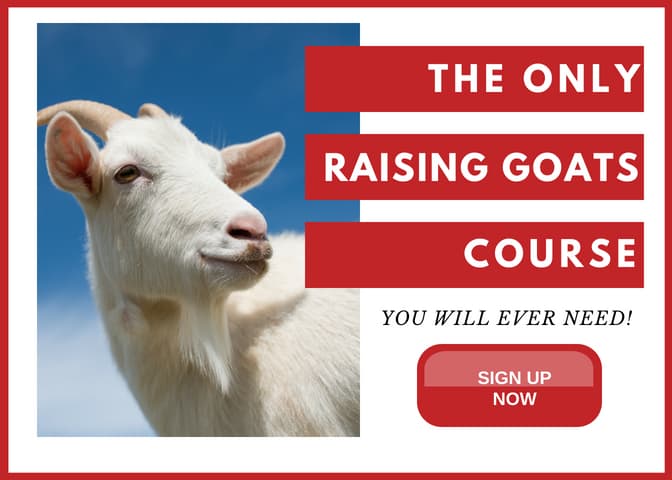
Or sign up for a FREE goat course on how to prevent, diagnose, and treat → anemia in goats ←
Possible Causes of Enterotoxemia
- Finding your goat’s head in the bag of grain after you know you locked the gate and checked twice.
- If goats or sheep are feed grain in groups, one may push the others out and get more grain than planned or even realized.
- The sudden change of being put out on lush green pasture in the spring.
- A young kid eating milk in excess from a heavy milking doe.
- Any sudden change in feed.
Enterotoxemia Symptoms to Watch For:
- An animal going abruptly off feed and becoming lethargic.
- Stomach pain
- Kicking belly
- Laying down and getting up repeatedly
- Laying on their sides
- Panting and crying out
- Diarrhea may develop and blood may be visible in the loose stool
- May lose the ability to stand, lay on their side, extending their legs. Because of the effect of the toxins on the brain, the animal will extend their head and neck over their withers. When this sign is seen, death will commonly occur in minutes to hours.
Treatment for Enterotoxemia:
- Contact your vet
- Your vet may treat a mild case with:
- Analgesics
- Probiotic
- Oral electrolyte solutions
- Or antisera (solution of concentrated antibodies that neutralize the toxins the bacteria produces).
- Your vet may treat a severe case with:
- Intravenous fluids
- Antibiotic therapy
- And possibly supplemental oxygen.
“Anti-toxin vaccines are used in medical emergencies when immediate but short-term protection is required. Goat producers use two anti-toxin injectables: C&D Anti-Toxin and Tetanus Anti-Toxin. C&D Anti-Toxin should be used whenever overeating disease, ruminal acidosis, or any rumen-related toxicity is suspected to be the cause of the goat’s illness. As with the vaccines (toxoids), the anti-toxins are used SQ (subcutaneously, i.e. under the skin). C&D Anti-Toxin is very safe to use and has a wide margin of error. It is one of the few medications which can be used without fear of hurting the animal.” ~Source
Tetanus is another disease no one wants to deal with in animals. The bacterium Clostridium tetani is deadly.
As shown below, this nasty bacteria is not one you want to mess with. A goat can get tetanus through…
- the soil
- feces (horse manure is a perfect place for tetanus to thrive)
- a cut on a fence or sharp object by just playing around
- you can also be the culprit. Trimming a goat’s hooves and drawing blood allows an opening for the bacteria to enter and wreak havoc.
- puncture wounds
- disbudding
- fights between goats
- dog bites
- castration
- tattooing
- dehorning
- kidding difficulties (dystocia).
- the rubbing of a collar on a chained or tethered goat can produce skin lesions
- elastrator bands used for castrating young males
- deep puncture wounds are of the biggest concern because the bacteria is sensitive to oxygen.
Tetanus flourishes in areas where oxygen is not plentiful, i.e. anaerobic conditions.
And prevention is key with tetanus as well.
If you are vaccinating, you will want to put this annual vaccination on your calendar so it’s not forgotten. And if you choose to not vaccinate, keep the Tetanus anti-toxin on hand. It instantly reverses the tetanus disease if given immediately.
And keep all areas clear of rusty objects and areas that could cut a goat.
Keep the area where the goats are living clean and sanitary.
Tetanus Symptoms to watch for:
- Rigid gait
- Unsteady gait
- Mild bloat
- Anxiety
- Unable to open mouth: “lockjaw”
- Muscle stiffness
- Drooping eyelids
- Changed voice
- Erect ears and tail
- Inability to eat or drink
- Excessive salivation
- Constipation
- Seizures
- Rigid extension of legs (front legs forward and back legs extended backward)
- The signs often get progressively worse and convulsions may occur.
- Death occurs from asphyxiation secondary to respiratory paralysis.
After the goat lays down and can’t get back up, death occurs quickly (usually within 36 hours or less).
Treatment for Tetanus:
- Contact your vet!
- High doses of penicillin
- Anti-inflammatories
- Tetanus anti-toxin. Before finding or doing anything with the initial site of injury, the tetanus antitoxin must be given. It should even be given before cleaning the wound to reduce the chance of the toxin being absorbed further while manipulating the damaged tissue. *Excessive tissue manipulation may make the animal dramatically worse. Open the wound or infection site to the air (remember, this bacteria is sensitive to oxygen!) and infiltrate with penicillin.
If you do decide to give the CD&T Shot to Your Goat…
Where do you give a goat or sheep a CD&T Shot?
This vaccine is given subcutaneous (SubQ, SQ). Subcutaneous means “under the skin” and implies just under the skin. With subcutaneous injections, a needle is inserted just under the skin.
- Prepare vaccine with proper dosage and 20 gauge needle.
- Lift the skin (in the armpit of the goat) into a tent.
- Insert the needle under the skin into the tent, toward the body. Make sure that the needle isn’t in the skin or muscle, or through the other side of the tent.
- Inject the medication and remove the needle.
- Rub the injection site for 30 seconds to prevent lumps or bumps.
More important information about the CDT Vaccination and what age to give CDT to goats:
• Follow the label directions carefully
• Some companies sell combination vaccines (CDT and protection against additional clostridial diseases) but contact your vet first to see if those diseases are common in your area before you spend any extra money.
**What is a clostridial disease? “The Clostridial diseases are a group of mostly fatal infections caused by bacteria belonging to the group called Clostridia. These organisms have the ability to form protective shell-like forms called spores when exposed to adverse conditions.” ~Source
• Vaccinate does about 30 days prior to kidding. This will provide protection to the kids through the colostrum.
**But if the doe has not been giving a priming booster, the pre-kidding annual shot probably won’t be effective.
**What is a priming booster? It is two shots administered three to four weeks apart. It usually is given when a doe is young but can be given at any point in her life.
• Vaccinate kids at 5-6 weeks of age. Give the priming booster 3-4 weeks later. If your doe was vaccinated properly, giving the CDT shot before a kid is 5 weeks old, may result in the kids not being protected and therefore the annual boosters may not be effective.
• If you are uncertain of the vaccination history of a doe or if colostrum intake of a kid is uncertain within the first 24 hours of birth, vaccinate the kid at 7-21 days of age and then give a booster 3-4 weeks later.
• Any other adult goats, yearling, or breeding bucks can be given the annual boosters 30 days prior to the breeding season or when the herd is receiving their booster vaccines.
• Give any new breeding bucks and does with unknown vaccination history two initial doses, three to six weeks apart, and then put them on the annual vaccination schedule.
• Some research has shown that goats might benefit from booster vaccinations twice a year, six months apart.
Other Alternatives to the CDT Vaccine for Goats
So remember, you don’t have to vaccinate. If you choose not to give this vaccine follow carefully and practice the safe feed management guidelines and the steps to prevent tetanus, both listed above.
I don’t know about you, but nothing about these diseases sounds pleasant.
If you do choose to vaccinate, mark your calendar each year and give your goats the CD&T vaccine.
Have you ever had any experiences with a goat getting Enterotoxemia or Tetanus?
More to Learn about goats:
You can read more about CD/T Vaccine: Goat Vaccination Program, Vaccination Schedule, Common Vaccinations for Goats
I am not a doctor or a veterinarian. The information herein is my opinion only and is not meant to replace professional, veterinary, or medical opinion. Any products mentioned here are not intended to diagnose, treat, prevent, or cure any disease. Statements made on this blog have not been evaluated by the FDA.
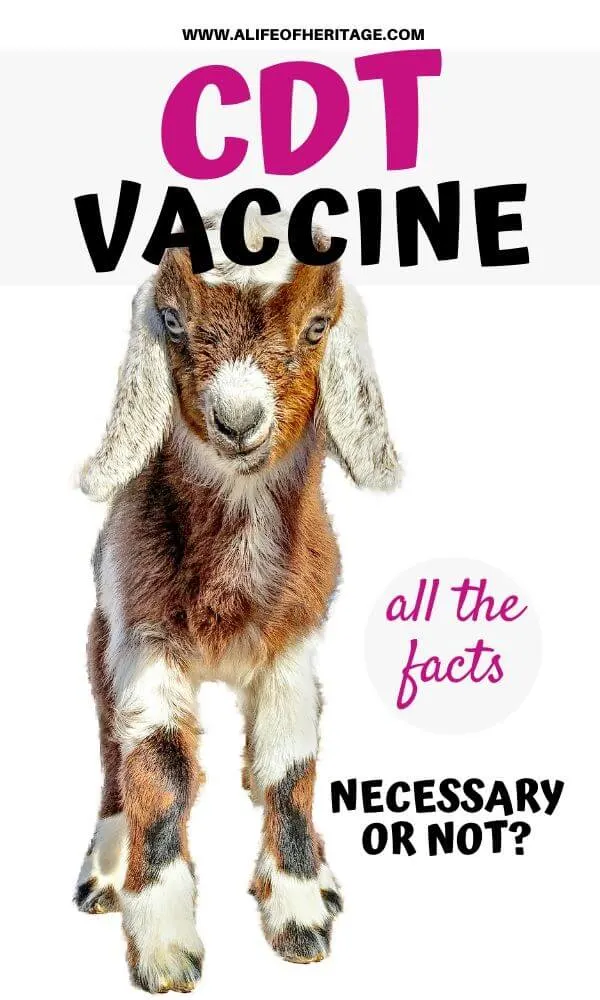


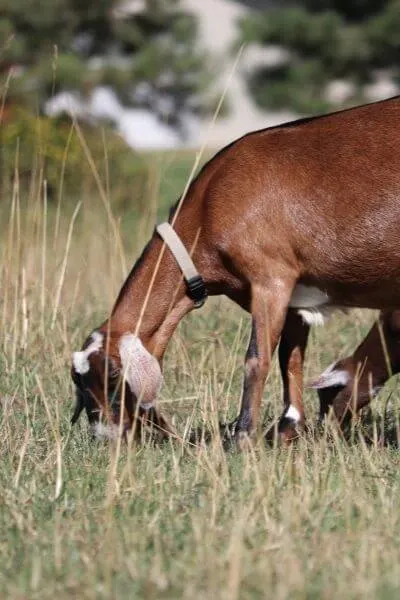
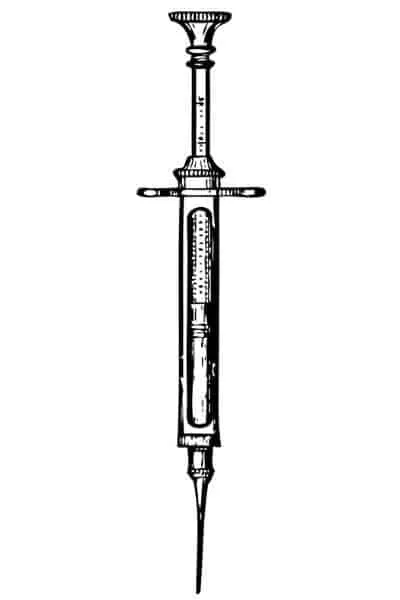
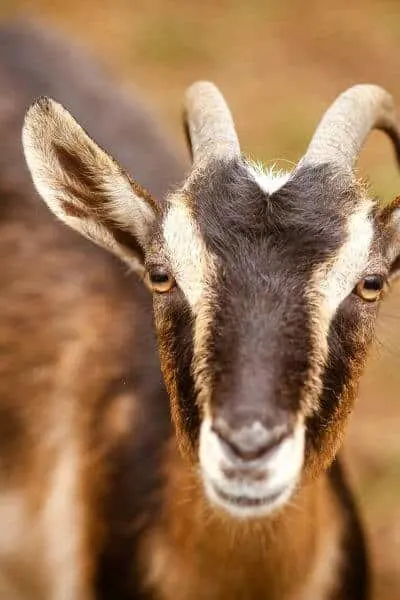


Ashley
Wednesday 21st of February 2024
Thank you for sharing all of this info! I did want to mention that tetanus is not necessarily found in rusty nails. It's a bacteria found in dirt, like you mentioned, and is anaerobic. It thrives in the absence of oxygen. Since rust is an oxide, it takes the oxygen out of its environment so it can create an opportunistic environment for the tetanus bacterium to grow. Deep, dirty wounds that do not bleed are at the most risk for infection. If the wound does bleed the risk is lower.
Thanks for talking about both sides! It's not always common these days.
Delci Plouffe
Wednesday 21st of February 2024
Great information!
Liz
Friday 26th of August 2022
Hello! Thank you for your informative article. One question I have, could this also apply to sheep? I can find info about not vaccinating goats with CDT, but nothing about sheep. We have both goats and sheep, and would prefer not to vaccinate unless absolutely necessary. Also wondering if it would affect ability to sell lambs if they'd not been vaccinated.
Delci Plouffe
Tuesday 27th of September 2022
I'm not sure about if it would be harder to sell. That's a good question! We haven't had sheep for years, but when we did, they were much more likely to die. I'd probably be more willing to do the CDT with the sheep than goats. But if they aren't allowed to bloat or get into grain and have their system upset, they'd probably be fine.
Aimee
Thursday 11th of February 2021
Thank you for an article that is open to not vaccinating. Having a vaccine injured child and an infant that died in part from a birth defect that was most likely caused by a “perfectly safe” medication, I question most western medical procedures and pharmaceuticals, though they do have their place also. I don’t believe it has to be one or the other. I’m still going to continue reading on the subject. But I wonder how common it is in those that don’t vax or in the pre-vax time? What was the death rate prior to the vaccine? If you have any information or links to these questions, I would appreciate it. But again thanks for providing both sides.
Laila
Friday 26th of November 2021
@Delci Plouffe, Hi Delci. I don’t vaccinate my daughter. And I have once read that goats have vitamin c formed in their bodies and when they get sick their produces huge amounts of vitamin c like up to 20 000 mg. If you’ve seen the lectures made by dr Susanne Humphries on tetanus she spoke about how tetanus is treatable using high doses of vitamin c. So I think wouldn’t goats immunity be able to naturally fight the tetanus bacteria? With tetanus wound care is extremely important. Essential oils are great natural anti septic like tea tree and myrrh. And also if I make ask do you vaccinate your kids and why? Thank you.
Delci Plouffe
Friday 26th of February 2021
I really think we all need to be aware that we can all make wise choices that make sense for our own situations. Our health and the health of our animals should be our own choices and no one else's. With that said, I'm so very sorry that your child was injured by vaccine and the loss of your other child. Honestly, I don't vaccine and I struggle with all of this too. I've never had a loss. But there is always potential I guess. Lots to think about!
Kayla Jaye
Saturday 24th of October 2020
I cannot put my goats thru another round of vaccines again. One screams as if they are killing him. This last round caused them to go down for a week. THREE days no food or water, and vet said it didn't concern her. I told her I read three days without water not good, she said don't believe online info. Right, so she can lie to me. She charged $200 to come out and check why they reacted to her vaccines. BOTH could NOT walk. She injured both their rear leg, injection site. I thought they were going to die and 8 days later still not back to themselves. She couldn't tell me what she did to cause it, but she made an extra $200 on this deal. She has officially been fired, so now I don't know what I'm going to do when she was the only livestock vet in our small town. I'll pray they stay healthy. I give them supplement meat block, so they should be ok without shots. They are pet dwarf goats in a residential yard, no other livestock around. Thank you.
Delci Plouffe
Thursday 19th of November 2020
I'm so sorry this happened to you! But I'm glad they made it through that and are recovering now!
Andrea
Tuesday 27th of August 2019
I never heard of rhe CD/T vaccine. i truly wish that I would of known about it. My 16 year old buck went down and had to be put to sleep. The symptoms sound like the enterotoxemia or tetanus. My othe two goats now have received the vaccine and hopefully, this will prevent another unwanted death of my goaties.
Delci Plouffe
Friday 20th of September 2019
Oh, my goodness. I'm so sorry that you had to go through that! I hope as well that it will prevent any more deaths as well!